Author: Darlene Chirman
I arrived at the Charles Darwin Research Center in early January 2022 to volunteer for three months with the Galapagos Verde 2050 Program (GV2050). As a retired restoration biologist, I had done ecological habitat restoration for twenty years in Southern California, then as a volunteer in Portland, Oregon where I now live. I had read about GV2050 when I applied, but I didn’t know much about what I would be doing to contribute. I thought I would be doing field habitat restoration as well as monitoring and planning. Activities familiar to me, but in very different habitats in arid island ecosytems near the Equator! I had visited the Galapagos 14 years ago as a tourist, traveling by boat to several islands for 8 days. At the time I thought I’d like to return to the Galapagos as a volunteer, here I am!
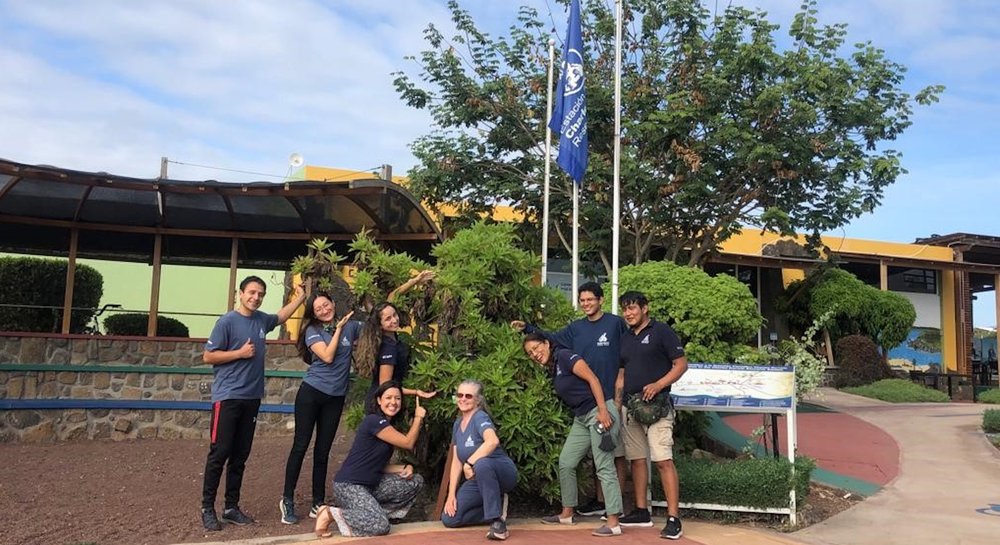
During my first week with GV2050 I began reading about the experiments in habitat restoration completed in the first phase of the project, to learn the best species and techniques to establish native and endemic plants in disturbed sites in the Galapagos archipelago. Sites have been impacted by invasive herbivores such as goats, now removed from most of the islands, invasive plants, or past human developments such as farms and a former World War II military base on Baltra Island. Patricia Jaramillo Díaz (Leader and Principal researcher for GV2050), Anna Calle (Researcher assistant) and I have been reviewing the results of restoration experiments to date on four of the remote islands, to determine what actions are needed for GV2050 to make recommendations to the Galapagos National Park Directorate (GNPD) for large scale restoration on the remote islands. We are drafting the next Action Plan for GV2050, covering the next 5 years. This has been my primary job while living and working at the Charles Darwin Foundation (CDF). I also joined staff members on trips to the GNP plant nursery in the highlands (transition zone), where we have a section to propagate plants for our experiments in restoration in other islands. Highlights of the trips were seeing giant tortoises of many sizes near a natural tortoise breeding area and a stand of endemic Scalesia pedunculata next to the greenhouse, planted when the GNP built the greenhouse 11 years ago.
We also visited two farms in the highlands, to monitor growth and survival of native and endemic plants installed by the project. There I saw for the first time, the invasive blackberry (Rubus niveus) and thought how different it looks than the invasive blackberry so prevalent in the Pacific Northwest where I live. A part of the GV2050 is working to local partners to establish ecological gardens using the native and endemic plants found on three inhabited islands. I was able to participate in an educational program and planting of Scalesia affinis with the students at the Special Education School in Puerto Ayora. This endemic plant called “Lechoso de lava” is vulnerable due to its low population on Santa Cruz Island. The costumes are Opuntia and Candelabra cacti (Fig. 1). GV2050 has partnered with this school since 2019, and it has the best ecological garden in an educational institution. We thank the teachers and students for their excellent care of the garden!
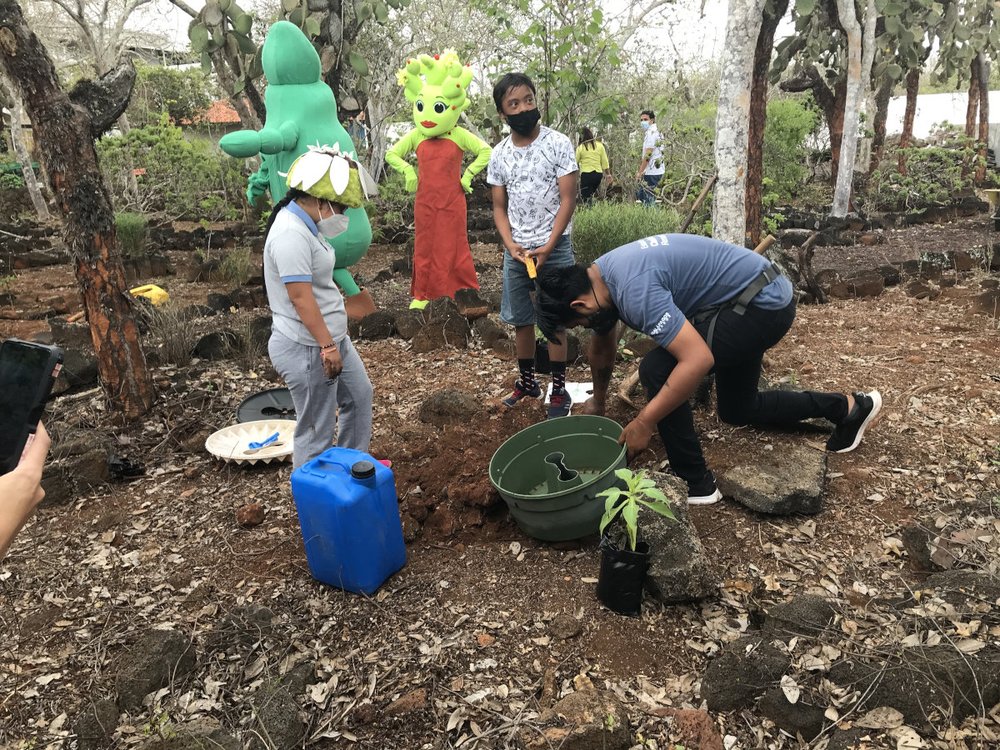
I traveled to Floreana Island for three days with Liliana Jaramillo and another volunteer, and met with on-island GV2050 staff Jhon Chango (field assistant). We worked in the plant nursery there and planted a native plant corridor for a public park in the town of Puerto Velasco Ibarra. The entire resident population of the island is about 150 people. Urban ecological restoration is a major project of GV2050, with important partnerships with GNP, local governments and educational institutions.
We planted two species of shrubs, Alternanthera filifolia (endemic) and “rodilla de caballo”, Volkameria mollis (native), in an experimental design with water saving technologies, to compare survival and growth. We are grateful to the local government which provided a truck tank of water to establish the plantings.
It took four of us all day to plant about 50 plants in this rocky soil. It was hot but satisfying work to complete. We also planted a few Lecocarpus pinnatifidus plants by a sign about the GV2050 we installed (Fig. 2). Even in this urban setting, I can see how difficult habitat restoration is in the arid zones of the Galapagos islands. Our next activity in Floreana was visiting one of the farms where GV2050 partnered with the farmer on sustainable agricultural techniques using water-saving technologies.
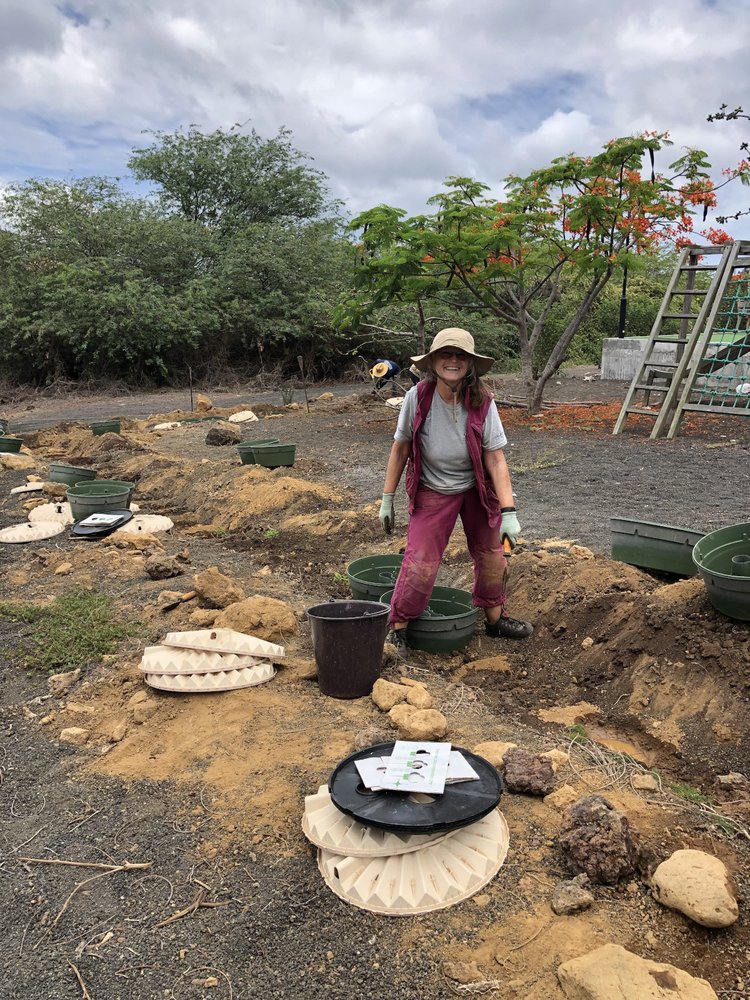
The greenhouse was installed last year and greatly facilitates the ecological restoration on the island. We prepared beds for cuttings of an endemic shrub “Margarita de Darwin”, Darwiniothamnus tenuifolius, subspecies is found on several islands in the Galapagos. We used hydrogel in ½ of the planting trays to see what is more effective, and added crushed lava gravel to the native soil to improve drainage (Fig. 3).
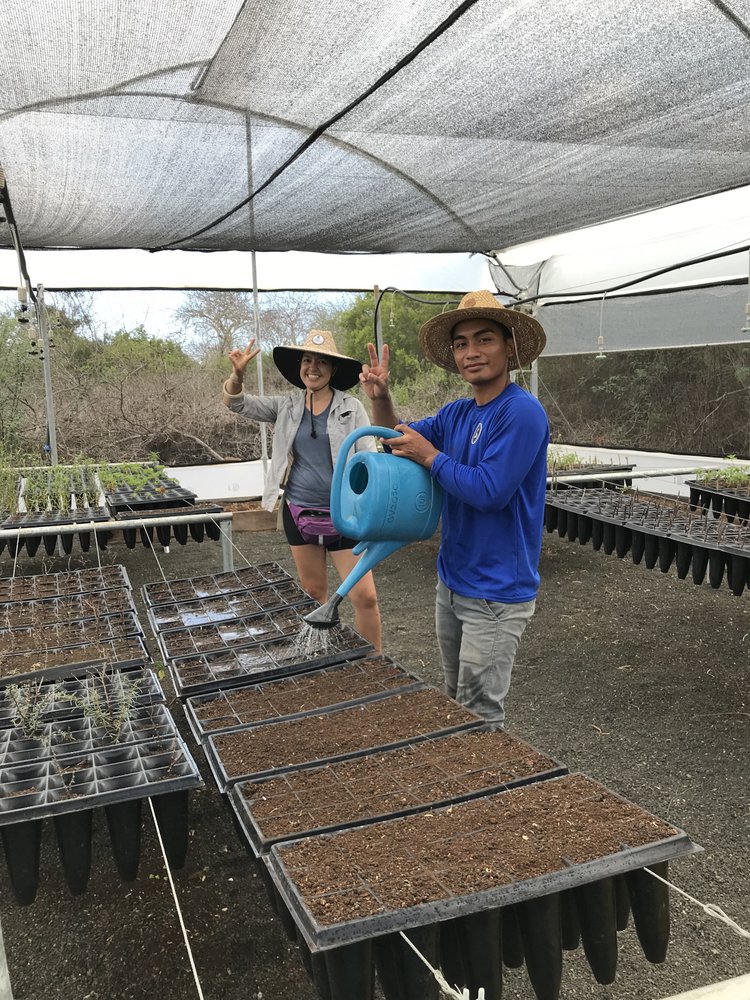
Also we traveled with with two co-workers to Baltra Island, to collect seeds from endemic and native plants for propagating the plants for the next experimental restoration. We took the bus, ferry, bus to the airport and took off in the project’s electric cart stored at the airport, to collect seeds and look at several of the restoration sites.
Pictured is Lechoso, Scalesia crockeri, a vulnerable endemic shrub. We collected lots of dried flowers, but found few seeds for propagating the plants needed for the experiments. The experiments are conducted to learn the most cost-effective strategies for planting, to recommend to the Galapagos National Park for large scale restoration of degraded habitats (Jaramillo et al 2020) (Fig. 4). This rugged part of Baltra appears not to have been degraded by the former American military base built in World War II, which disturbed much of Baltra. Some species have recovered on their own, but active restoration is needed to re-establish species diversity.
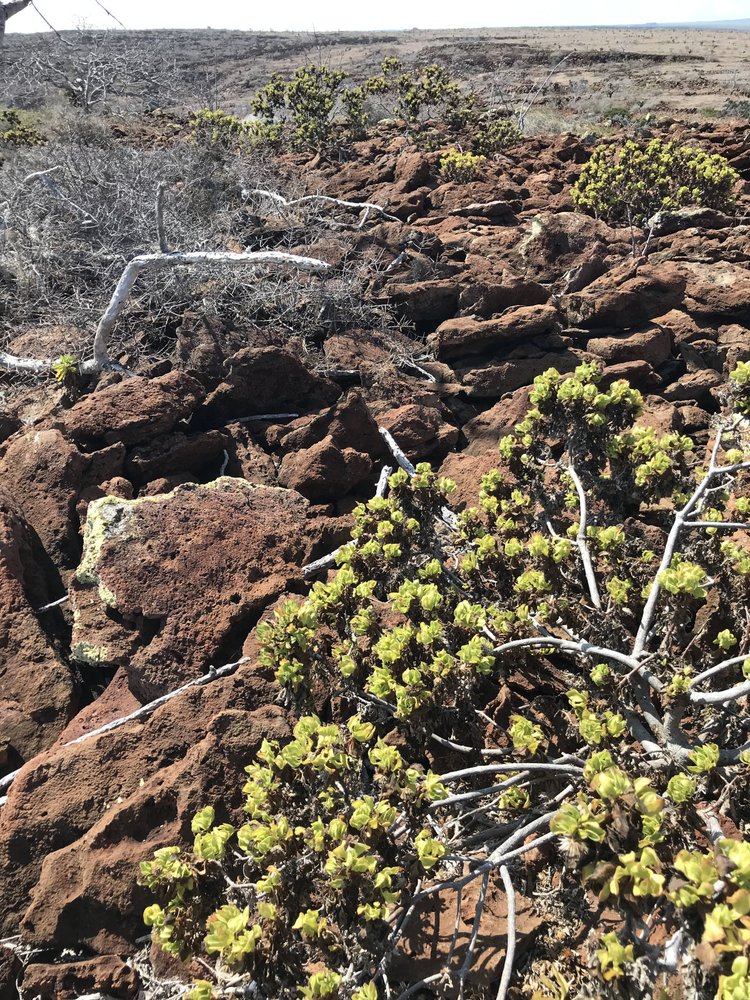
Below is a restoration site in arid Baltra, with water-saving technologies treatments, to compare with control plants without (Fig. 5). Fences protect Opuntia until they are big enough to tolerate herbivory by land iguanas. Opuntia is a primary food source for land iguanas. There are no Giant tortoises on Baltra, but on other islands Opuntia is primary food source for them as well. These herbivores serve to disperse the seeds of cacti, which survive passage in the alimentary tract of these animals.
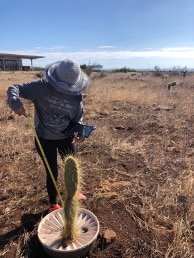
Another task I have been doing about every two weeks during my stay here is assisting in the monitoring of an endangered endemic plant called Lecocarpus lecocarpoides, found only on Española Island and several islets (Brok et al. 2007). This plant was thought to be extinct, probably due to feral goat herbivory (goats removed 1978), with no observations for many years until a small population was found in 2020 at Punta Manzanillo on Española (Jaramillo, 2021).
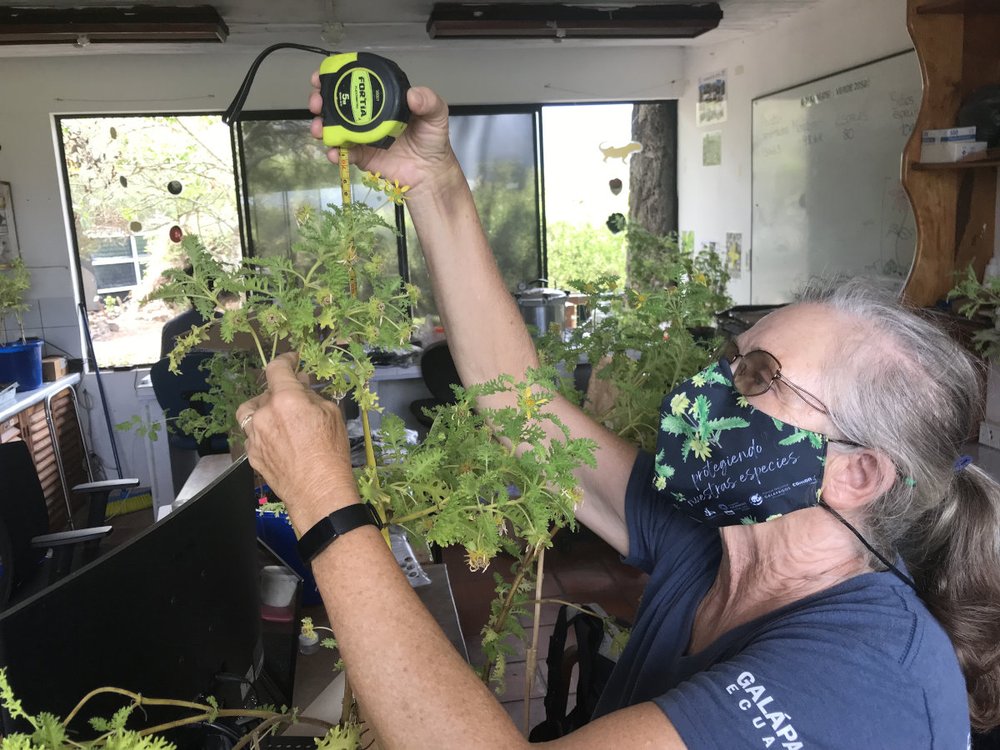
We have a group of 26 plants grown in the lab from seeds we collected at that site (fig. 6). We record survival, plant height, number of flowers, immature seed pods and mature seed pods. As an annual plant, these are beginning to senesce, although with regular water they are larger and have survived longer than plants at Punta Manzanillo. We are learning about their growth habits as well as collecting seed for experiments that can recover the species. I’m sad not to be able to see the plants growing in the wild, but getting to the site usually involves a 4-hour boat ride and camping for several days.
You can see that I’ve been able to do a variety of tasks during my volunteer stint at Galapagos Verde 2050 Program. While working on the Action Plan, reading reports and visiting the Baltra restoration experiments, I can see that ecological restoration in the Galapagos archipelago is very challenging. This is especially so in the remote islands, which mostly don’t have any water source. Thus, to replant native habitats in degraded sites, one has to collect seeds, grow out the plants in a plant nursery on Santa Cruz Island, which can take 2-3 years for Opuntia. A planting expedition requires personnel, plants, tools, water for the plants, camping gear, food and water for the crew for several days. In this arid environment, survival can be low, even with water-saving technologies.
From my reading and my prior experience in habitat restoration, particularly at The Nature Conservancy preserve in central California where I did my thesis research, I am focusing on ways to promote natural regeneration, that may scale up to landscape-level ecosystem recovery. One example is creation of a string of restoration sites on Baltra that are close enough together to facilitate wildlife movement between the clusters—especially birds and iguanas—that can benefit the wildlife but also spread propagules to initiate natural restoration between the clusters, creating a restoration corridor between intact vegetation stands. Another example is taking advantage of El Niño events; with increased rainfall, most species grow faster. However, Opuntia and at least one species of Scalesia, S. crockeri (Baltra) are sometimes killed by El Niño rains. Opuntia takes up so much water, and the ground gets so saturated, that the adult plants can collapse. However, they can produce many seedlings and rooted cladodes (cactus pads) around the deceased adult. We can translocate seedlings and cladodes to start new populations, protect them with fencing, water them at planting and in the dry season, control weeds, and possibly use soil additives of hydrogel and/or bio-char to increase soil moisture. If effective, these techniques can by-pass several steps in propagation of plants, thus decreasing the investment of time and money, providing more cost-effective restoration.
While my work with Galapagos Verde has been very rewarding, I have also had time to explore some of the Galapagos. I’ve been snorkeling at several beaches and Santa Fe Island, kayaking, and hiking up Puntudo in the highlands. I’ve been able to socialize with my co-workers, with other volunteers living in the volunteer compound at the Charles Darwin Research Station. I’ve seen many birds, such as Blue-footed boobies, the flamingoes at El Garrapatero Beach; I accompanied a graduate student on his study monitoring trail of the Galapagos rail in the highlands, and heard many but did not see this secretive bird. I have watched sea turtles and dolphins. I have loved my time in the Galapagos Islands, and feel I have made some important contributions to the ecosystem recovery of the islands.
GV2050 project is implemented in collaboration with the Charles Darwin Foundation and Galapagos National Park Directorate. The project is financially viable thanks to the support of the COmON Foundation. We would like to thank the park rangers that support our work, and the CDF team, most notably Anna Calle and Patricia Jaramillo Díaz for their input on earlier drafts. These are just some of the seven islands where the GV2050 project has implemented restoration work, you can read more about our results on here: effectiveness of water-saving technologies for restoring Opuntia cacti, cost‐effectiveness of water‐saving technologies, Action Plan for the Ecological Restoration of Baltra and Plaza Sur, and Galapagos Verde 2050 Vol1.
A new non-profit has recently been established making it easier to donate to the Charles Darwin Foundation to support their important scientific work to aid in the conservation of the Galapagos National Park: Friends of the Charles Darwin Foundation for the Galapagos Islands is a 501(c)3, so can accept tax-deductible donations under the US tax code. To celebrate this, an anonymous donor has agreed to match the first $100,000 in donations. I made a donation to support the Galapagos Verde 2050 Program!
References
Brok, C. S., & Adsersen, H. (2007). Morphological variation among populations of Lecocarpus (Asteraceae) on the Galapagos Islands. Botanical Journal of the Linnean Society.
Jaramillo, P. 2021, (February 22). Lecocarpus species rediscovered on Española Island after decades of not being registered! // www.darwinfoundation.org/Es/Articulos-Blog/675-Especie-de-Lecocarpus-Que-Dejo-de-Registrarse-Por-Decadas-Es-Reencontrada-En-La-Isla-Espanola
Jaramillo, P, Tapia, W., Gibbs, J. 2017. Action Plan for the Ecological Restoration of Baltra and Plaza Sur Islands. Charles Darwin Foundation. Pl 1-56.Jaramillo, P., Tapia, W., Negoita, L., Plunkett, E., Guerrero, M., Mayorga, P., Gibbs, J. 2020. The Galapagos Verde 2050 Project, Vol. 1. Charles Darwin Foundation, Puerto Ayora, Galápagos, Ecuador. Pp 1-130.





